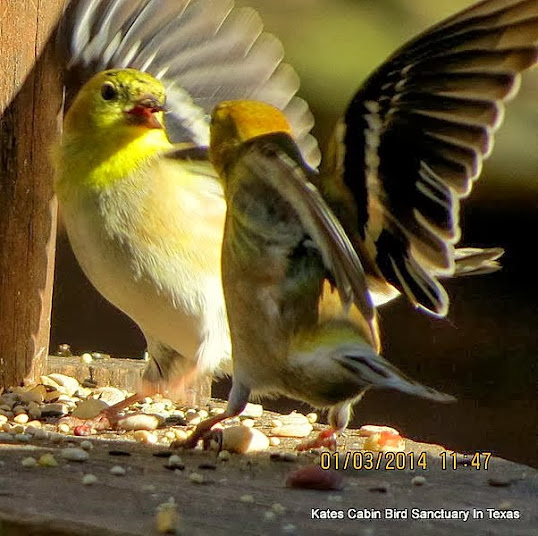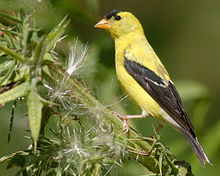
Hi Everybody!!
The first guests of the Bird Sanctuary each year are the Goldfinches. They began arriving on Christmas and have been coming in daily. Their traveling companions are the pine siskins. The resident Cardinals behave as if the small birds are chicks. They watch over them in a protective fashion. The squirrels are important in the backyard bird mix as they warn all the birds if a nasty feral cat is hunting. Anyway, I have shared info below in regards to the Goldfinch (from Wikipedia). The goldfinches enjoy the seed sock, which is a net filled with Nyger seed. The beak-blade woodpecker made a hole in the white one. I found the last seed sock in this town yesterday, and already a squirrel opened the hole! These are fun little birds to watch! Enjoy!


Highlight Quick Clips created by G+ Auto Backup




link to photostudy in G+Album:
https://plus.google.com/u/0/photos/117645114459863049265/albums/5964469419358643761

https://en.wikipedia.org/wiki/American_Goldfinch
American Goldfinch
From Wikipedia, the free encyclopedia
The American Goldfinch (Carduelis tristis), also known as the Eastern Goldfinch, is a small North American bird in the finch family. It is migratory, ranging from mid-Alberta toNorth Carolina during the breeding season, and from just south of the Canadian border toMexico during the winter.
The only finch in its subfamily that undergoes a complete molt, the American Goldfinch displays sexual dimorphism in its coloration; the male is a vibrant yellow in the summer and an olive color during the winter months, while the female is a dull yellow-brown shade which brightens only slightly during the summer. The male displays brightly coloredplumage during the breeding season to attract a mate.
The American Goldfinch is a granivore and adapted for the consumption of seedheads, with a conical beak to remove the seeds and agile feet to grip the stems of seedheads while feeding. It is a social bird, and will gather in large flocks while feeding and migrating. It may behave territorially during nest construction, but this aggression is short-lived. Its breeding season is tied to the peak of food supply, beginning in late July, which is relatively late in the year for a finch. This species is generally monogamous, and produces one brood each year.
Human activity has generally benefited the American Goldfinch. It is often found in residential areas, attracted to bird feeders which increase its survival rate in these areas.Deforestation also creates open meadow areas which are its preferred habitat.
| American Goldfinch | |
|---|---|
 | |
| Male American Goldfinch in winter plumage | |
| Conservation status | |
| Scientific classification | |
| Kingdom: | Animalia |
| Phylum: | Chordata |
| Class: | Aves |
| Order: | Passeriformes |
| Family: | Fringillidae |
| Genus: | Carduelis |
| Species: | C. tristis |
| Binomial name | |
| Carduelis tristis (Linnaeus, 1758) | |
| Subspecies | |
| |
 | |
| Breeding range Year-round range Wintering range | |
Behavior[edit]
The American Goldfinch is gregarious during the non-breeding season, when it is often found in large flocks, usually with other finches. Flocks generally fly in an undulating pattern, creating a wave-shaped path.[21] During the breeding season, it lives in loosecolonies. While the nest is being constructed, the male will act aggressively toward other males who intrude into his territory, driving them away, and the female reacts in the same way toward other females. This aggressiveness subsides once the eggs have been laid.[23]
The American Goldfinch does not act aggressively toward predators within its territory; its only reaction is alarm calling. Predators include snakes, weasels, squirrels, and Blue Jays, which may destroy eggs or kill young, and hawks and cats, which pose a threat to both young and adults. As of 2007, the oldest known American Goldfinch was 10 years and 5 months old.[24]
Diet[edit]
The American Goldfinch is a diurnal feeder. According to the Cornell Lab of Ornithology, the species is one of the strictest vegetarians in the bird world.[24] It is mainly granivorous, but will occasionally eat insects, which are also fed to its young to provide protein. Its dietconsists of the seeds from a wide variety of annual plants, often those of weeds grasses and trees, such as thistle, teasel, dandelion, ragweed, mullein, cosmos, goatsbeard,sunflower, and alder.[19] However, it also consumes tree buds, maple sap, and berries. It will eat at bird feeders provided by humans, particularly in the winter months, preferringNiger seed (commonly and erroneously called thistle seed).[25]
Unlike some finch species, the American Goldfinch uses its feet extensively in feeding. It frequently hangs from seedheads while feeding in order to reach the seeds more easily. In the spring, the American Goldfinch feeds on the catkins hanging from birches and alders by pulling one up with its beak and using its toes to hold the catkin still against the branch. This dexterity enables it to take advantage of food sources relatively inaccessible to potential competitors, increasing its chances of survival.[13]
Relationship with humans[edit]
The American Goldfinch is found in residential areas throughout its range. Backyard birders attract it using feeders containing Nyjer thistle seed,[25] or by planting grasses and perennial plants, such as zinnias, cosmos, bee balm, or globe thistle, which produce seedheads favored by finches. Although some controversy surrounds bird feeding (see bird feeder for details), an increase in backyard feeding by humans has generally been beneficial to this species.[25]
The American Goldfinch is not threatened by human activity, and is widespread throughout its range.[1][7] The clearing of forests by humans, though harmful to many species, has benefited the American Goldfinch. Clearing of woodlands causes declines in numbers of neotropical migrants, while favoring short-distance migrants and permanent residents.[30] This benefits the American Goldfinch both as a short-distance migrant, and because the created open areas are the preferred environment of the bird, where weeds thrive which produce the primary food source of the American Goldfinch.[14]
The American Goldfinch, or Eastern Goldfinch, is also the state bird of Iowa, New Jersey, and Washington.[31] It was chosen by schoolchildren in Washington State in 1951.[9]
(please see link for complete article)



link to photostudy in G+ Album:
https://plus.google.com/u/0/photos/117645114459863049265/albums/5964848110157216753


O+O





No comments:
Post a Comment
Hi Everybody! Please say hello and follow so I know you are here! Due to the inconsideration of people trying to put commercials on my blog comment area, I have restricted use of anonymous posts. Sorry that some hurt all.
My public email is katescabin@gmail.com No spammers or trolls